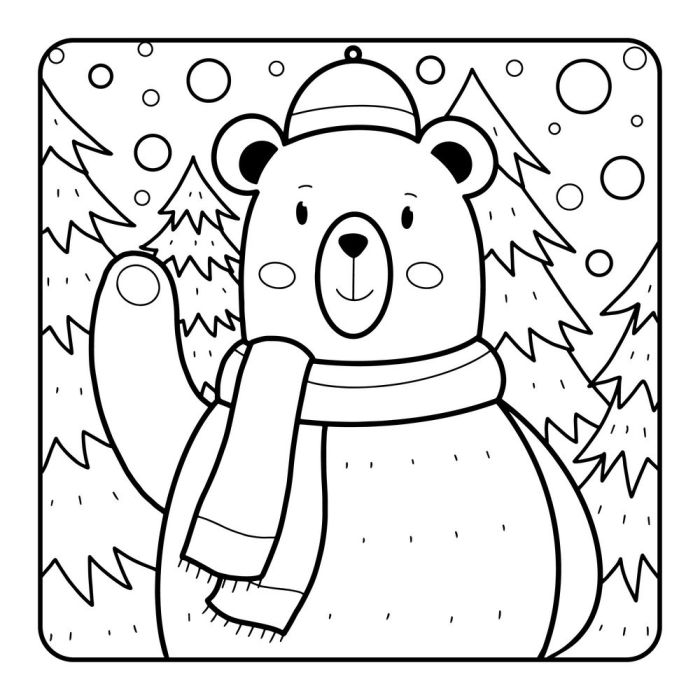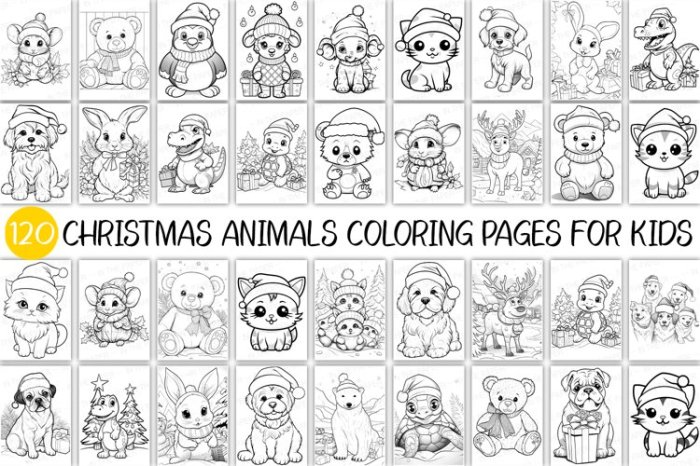Color Palette and Visual Style

Animals surrounding a christmas coloring sheet – Choosing the right colors and visual style is crucial for creating a captivating Christmas coloring sheet that appeals to children. The palette should evoke the spirit of the season while allowing for creative expression. The visual style will determine the overall look and feel, influencing how easily children can color within the lines and how engaging the final product is.A festive color palette for a Christmas coloring sheet should include a mix of traditional and unique colors to maintain visual interest and cater to different preferences.
Traditional Christmas Colors and Their Mood
Traditional Christmas colors immediately evoke the holiday spirit. These include deep reds, rich greens, and snowy whites. Reds symbolize joy, excitement, and warmth, while greens represent nature, peace, and hope. Whites represent purity, innocence, and the crispness of winter. Using these colors together creates a classic, comforting, and warm feeling, ideal for a traditional Christmas coloring sheet.
A coloring page primarily using these colors might depict a cozy scene, like a family gathered around a fireplace or a snowy winter wonderland. The warm tones create a sense of comfort and nostalgia.
Unique Color Combinations and Their Impact
Beyond the traditional palette, incorporating unique color choices can add a modern twist or a playful element. Consider adding shimmering golds and silvers for a touch of elegance and sparkle. These metallic accents can be used sparingly to highlight details or add a festive glow. Blues and purples, often associated with winter nights, can add a touch of magic and mystery.
Pastel shades of pink, teal, and lavender offer a softer, gentler approach, suitable for younger children or those who prefer a less intense color scheme. A coloring sheet utilizing these unique colors could portray a more whimsical scene, perhaps featuring fantastical creatures or a stylized Christmas tree. The introduction of cooler tones can shift the mood from warm and cozy to more serene and magical.
Visual Style Considerations
The visual style of the coloring sheet should be carefully considered. A realistic style might depict detailed animals with intricate fur textures and realistic expressions. This style would require more advanced coloring skills and might be more suitable for older children. A cartoonish style, on the other hand, features simpler shapes, exaggerated features, and bolder Artikels. This style is easier for younger children to color and allows for greater creative freedom.
Yo, check out this rad Christmas coloring sheet—it’s got, like, a whole crew of animals chillin’ around the tree. Need more animal pics to color? Then hit up this awesome site for animals pictures for coloring , so you can totally level up your coloring game. After you’re done with those, get back to those festive critters on your Christmas sheet!
Finally, a minimalist style uses simple lines and shapes, focusing on clean aesthetics and negative space. This style can be both sophisticated and appealing, but might require a more mature understanding of color and composition. The chosen style should align with the target age group and the overall aesthetic desired. For example, a coloring sheet featuring cartoonish animals would likely be more engaging for younger children than one featuring realistic renderings.
Illustrative Details and Elements: Animals Surrounding A Christmas Coloring Sheet

Adding festive details and intricate elements to your animal Christmas coloring sheet will significantly boost its visual appeal and make it more engaging for users. Think beyond simple Artikels; let’s bring the scene to life with rich textures and charming details.Adding carefully chosen details will make the coloring sheet more interesting and enjoyable for the user. The level of detail will also help to challenge and engage colorists of different skill levels.
Festive Details for the Christmas Scene
The animals should be placed within a vibrant Christmas setting. Consider incorporating elements like a decorated Christmas tree, complete with colorful ornaments and a star on top. Include presents wrapped in festive paper with ribbons and bows scattered around the base of the tree. A light dusting of snow on the ground and perhaps some snowflakes falling from the sky would add to the winter wonderland feel.
These elements are instantly recognizable and associated with Christmas, creating a strong festive atmosphere. A cozy cabin in the background could further enhance the sense of a heartwarming Christmas scene.
Intricate Details: Animal Fur and Clothing Patterns
A key element to enhance the coloring sheet’s visual richness is the inclusion of intricate details on the animals themselves. For example, depict the fur texture of a fox with short, slightly uneven strokes, suggesting fluffiness. A bear could have longer, more defined strokes to convey a coarser fur. The clothing on the animals, if any, can feature detailed patterns.
A reindeer might wear a tiny scarf with a simple, repeating snowflake pattern, while a penguin could have a festive hat with a complex geometric design. These details allow for more creative coloring and add a sense of realism and charm. Imagine a squirrel wearing a miniature knitted sweater with a cable-knit pattern—this would be both visually interesting and enjoyable to color.
Enhancing Visual Richness and Engagement
The inclusion of these details significantly enhances the coloring sheet’s visual richness and engagement. The festive elements create a strong Christmas theme, immersing the colorist in a joyful holiday atmosphere. The intricate details, such as fur textures and clothing patterns, provide a challenge and opportunity for creative expression. This detailed approach transforms a simple Artikel into a captivating work of art, encouraging users to spend more time coloring and creating their own unique interpretation of the scene.
The variety of textures and patterns caters to different coloring preferences and skill levels, making the sheet appealing to a wider audience.
Adapting for Different Age Groups

Designing coloring sheets for children requires considering their developmental stages. Younger children have different fine motor skills and attention spans compared to older children, necessitating adjustments in design complexity to ensure appropriate challenge and engagement. A well-designed coloring sheet should be both fun and developmentally appropriate.Creating engaging coloring sheets involves tailoring the design to the target age group.
This means adjusting the complexity of shapes, the size of coloring areas, and the overall level of detail. Younger children benefit from larger, simpler shapes that are easier to color within, while older children can handle more intricate designs and smaller spaces, allowing for greater creativity and fine motor skill development.
Simple vs. Complex Animal Designs, Animals surrounding a christmas coloring sheet
The following examples illustrate how a single animal design can be adapted for different age groups. We will use a reindeer as our example.
- Simpler Reindeer (for younger children, ages 3-5):
- Large, chunky body with a simple, rounded shape.
- Large, easily colored antlers with only a few branches.
- Large, simple eyes and nose.
- Minimal details – no fur texture or intricate facial features.
- Wide, clearly defined areas for coloring, minimizing the risk of going outside the lines.
- More Complex Reindeer (for older children, ages 8-12):
- More detailed body shape with curves and slight variations in thickness.
- Intricate antlers with many branches, varying in size and thickness.
- Smaller, more detailed eyes and nose with shading possibilities.
- Inclusion of fur texture through subtle line variations or patterns.
- Smaller coloring areas, requiring more precision and control.
- Potential for adding background details, such as a snowy landscape.
Key Design Aspects for Different Age Groups
Several key design elements must be adjusted to suit different age groups. These include:
- Shape Complexity: Younger children benefit from simpler, more geometric shapes, while older children can handle more complex, organic shapes with curves and details.
- Line Thickness: Thicker lines are easier for younger children to color within, reducing frustration. Older children can handle thinner lines and more intricate designs.
- Area Size: Larger coloring areas are better for younger children to manage, promoting success and confidence. Older children can work with smaller areas, improving fine motor skills and attention to detail.
- Detail Level: Limit details for younger children to avoid overwhelming them. Older children can handle more intricate designs, patterns, and textures.
- Color Palette: Consider using brighter, bolder colors for younger children, while older children may appreciate a more nuanced or subtle palette.
Questions Often Asked
What software is best for creating this coloring sheet?
Vector-based programs like Adobe Illustrator or Inkscape are ideal for creating clean lines and easily scalable designs. Raster-based programs like Photoshop can also be used, but require more attention to resolution.
How can I ensure the coloring sheet is printable on standard paper?
Maintain a high resolution (at least 300 DPI) and avoid overly complex details that might cause printing issues. Test print on standard paper before mass production.
What are some alternative Christmas animals to consider?
Consider foxes, owls, rabbits in winter attire, or even mythical creatures like snow sprites or yetis for a unique twist.
